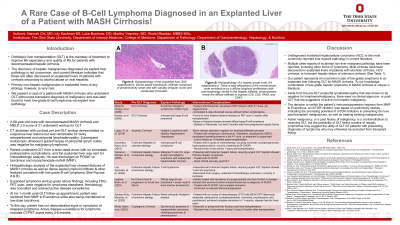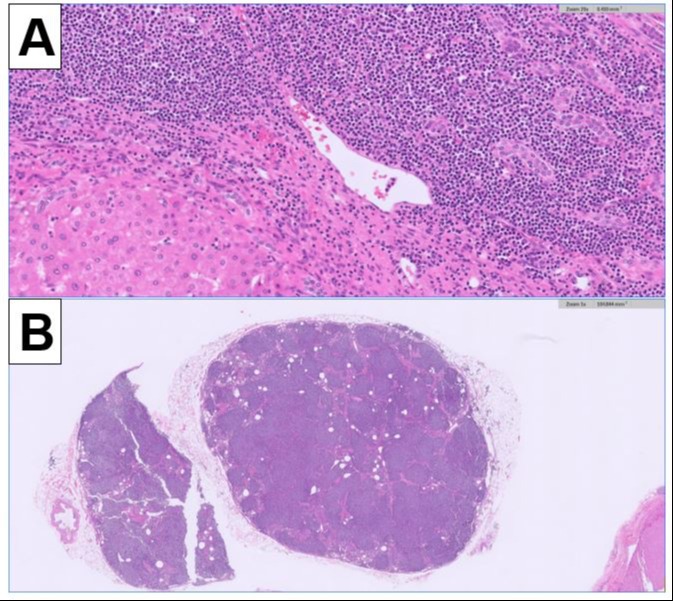Monday Poster Session
Category: Liver
P3148 - A Rare Case of B-Cell Lymphoma Diagnosed in an Explanted Liver in a Patient With MASH Cirrhosis!
Monday, October 28, 2024
10:30 AM - 4:00 PM ET
Location: Exhibit Hall E

Has Audio

Hannah Chi, MD
The Ohio State University
Columbus, OH
Presenting Author(s)
Hannah Chi, MD1, Lily Kaufman, BS2, Luke Bushrow, DO2, Martha Yearsley, MD2, Khalid Mumtaz, MBBS, MSc2
1The Ohio State University, Columbus, OH; 2The Ohio State University Wexner Medical Center, Columbus, OH
Introduction: Finding hepatic malignancies in explanted livers is not uncommon. Current literature describes these largely being seen in explanted livers of patients whose primary reason for liver transplantation (LT) is due to cirrhosis secondary to alcoholism or viral hepatitis. However, finding primary non-hepatic malignancies in explanted livers of any etiology are indeed very rare. On account of its rarity, we present a case of low-grade B-cell lymphoma in the liver explant of a patient with metabolic dysfunction-associated steatohepatitis (MASH) who underwent liver transplantation.
Case Description/Methods: A 69-year-old male with a history of diabetes mellitus, hypothyroidism, and newly diagnosed MASH cirrhosis underwent evaluation for a LT. His pre-transplant evaluation was significant for bulky retroperitoneal and periportal lymphadenopathy noted on abdominal CT, though the follow-up periportal lymph node biopsy to evaluate this finding was negative for malignancy/lymphoma. He underwent LT without major complications and was surprisingly found on histopathologic analysis of his explanted liver to have low-grade B-cell lymphoma. Workup for systemic findings of lymphoma was negative in the postoperative hospital course. Patient was discharged home on tacrolimus and mycophenolate mofetil, the latter of which was switched to everolimus at the 1-month follow-up. Patient was also advised a close-follow-up strategy for continued lymphoma surveillance via 3-monthly CT/PET scan.
Discussion: We reported a very rare case of low-grade B-cell lymphoma in a patient who underwent LT for MASH cirrhosis. No specific treatment was advised by hematology for this diagnosis as the primary disease has been addressed with LT.
In conclusion, we are not only highlighting the rarity of this clinical case, but also noting that the immunosuppressant switch from tacrolimus to everolimus was based on promising data outlining potential anti-oncogenic benefits of the latter on post-transplant patients. Additionally, the possibility of OLT being curative of pre-existing lymphoma should challenge the current eligibility criteria that excludes patients with active extrahepatic malignancies from being considered for LT.

Note: The table for this abstract can be viewed in the ePoster Gallery section of the ACG 2024 ePoster Site or in The American Journal of Gastroenterology's abstract supplement issue, both of which will be available starting October 27, 2024.
Disclosures:
Hannah Chi, MD1, Lily Kaufman, BS2, Luke Bushrow, DO2, Martha Yearsley, MD2, Khalid Mumtaz, MBBS, MSc2. P3148 - A Rare Case of B-Cell Lymphoma Diagnosed in an Explanted Liver in a Patient With MASH Cirrhosis!, ACG 2024 Annual Scientific Meeting Abstracts. Philadelphia, PA: American College of Gastroenterology.
1The Ohio State University, Columbus, OH; 2The Ohio State University Wexner Medical Center, Columbus, OH
Introduction: Finding hepatic malignancies in explanted livers is not uncommon. Current literature describes these largely being seen in explanted livers of patients whose primary reason for liver transplantation (LT) is due to cirrhosis secondary to alcoholism or viral hepatitis. However, finding primary non-hepatic malignancies in explanted livers of any etiology are indeed very rare. On account of its rarity, we present a case of low-grade B-cell lymphoma in the liver explant of a patient with metabolic dysfunction-associated steatohepatitis (MASH) who underwent liver transplantation.
Case Description/Methods: A 69-year-old male with a history of diabetes mellitus, hypothyroidism, and newly diagnosed MASH cirrhosis underwent evaluation for a LT. His pre-transplant evaluation was significant for bulky retroperitoneal and periportal lymphadenopathy noted on abdominal CT, though the follow-up periportal lymph node biopsy to evaluate this finding was negative for malignancy/lymphoma. He underwent LT without major complications and was surprisingly found on histopathologic analysis of his explanted liver to have low-grade B-cell lymphoma. Workup for systemic findings of lymphoma was negative in the postoperative hospital course. Patient was discharged home on tacrolimus and mycophenolate mofetil, the latter of which was switched to everolimus at the 1-month follow-up. Patient was also advised a close-follow-up strategy for continued lymphoma surveillance via 3-monthly CT/PET scan.
Discussion: We reported a very rare case of low-grade B-cell lymphoma in a patient who underwent LT for MASH cirrhosis. No specific treatment was advised by hematology for this diagnosis as the primary disease has been addressed with LT.
In conclusion, we are not only highlighting the rarity of this clinical case, but also noting that the immunosuppressant switch from tacrolimus to everolimus was based on promising data outlining potential anti-oncogenic benefits of the latter on post-transplant patients. Additionally, the possibility of OLT being curative of pre-existing lymphoma should challenge the current eligibility criteria that excludes patients with active extrahepatic malignancies from being considered for LT.

Figure: Figure A: Histopathology of the explanted liver. Dense septal lymphocytic infiltrate comprised of predominantly small cells with variably irregular nuclei and condensed chromatin.
Figure B: Histopathology of a hepatic lymph node. There is total effacement of the normal lymph node architecture by a diffuse lymphoid proliferation with cytomorphology similar to the hepatic infiltrate. Immunostains reveal the diffuse infiltrate to express C20 (shown below), CD5 (shown below), PAX5, and CD43.
Figure B: Histopathology of a hepatic lymph node. There is total effacement of the normal lymph node architecture by a diffuse lymphoid proliferation with cytomorphology similar to the hepatic infiltrate. Immunostains reveal the diffuse infiltrate to express C20 (shown below), CD5 (shown below), PAX5, and CD43.
Note: The table for this abstract can be viewed in the ePoster Gallery section of the ACG 2024 ePoster Site or in The American Journal of Gastroenterology's abstract supplement issue, both of which will be available starting October 27, 2024.
Disclosures:
Hannah Chi indicated no relevant financial relationships.
Lily Kaufman indicated no relevant financial relationships.
Luke Bushrow indicated no relevant financial relationships.
Martha Yearsley indicated no relevant financial relationships.
Khalid Mumtaz indicated no relevant financial relationships.
Hannah Chi, MD1, Lily Kaufman, BS2, Luke Bushrow, DO2, Martha Yearsley, MD2, Khalid Mumtaz, MBBS, MSc2. P3148 - A Rare Case of B-Cell Lymphoma Diagnosed in an Explanted Liver in a Patient With MASH Cirrhosis!, ACG 2024 Annual Scientific Meeting Abstracts. Philadelphia, PA: American College of Gastroenterology.
